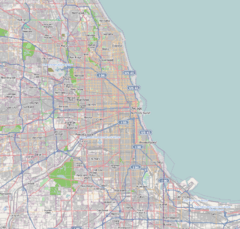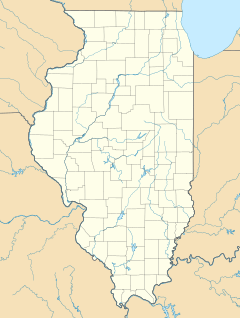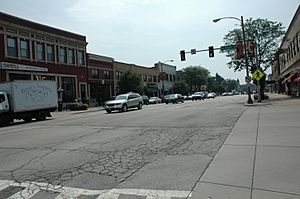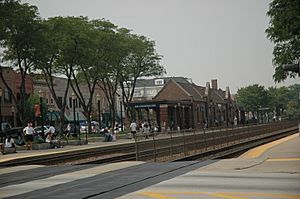La Grange, Illinois facts for kids
Quick facts for kids
La Grange, Illinois
|
||
|---|---|---|
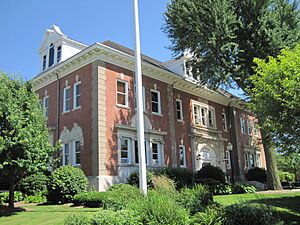
La Grange Village Hall
|
||
|
||
| Etymology: French: la grange (the barn) |
||
| Motto(s):
Tradition & Pride – Moving Forward
|
||
| Anthem: My La Grange by Jimmy Dunne | ||
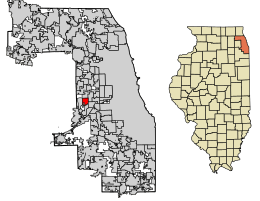
Location of La Grange in Cook County, Illinois
|
||
| Country | ||
| State | ||
| County | Cook | |
| Township | Lyons Township | |
| Settled | 1830 | |
| Incorporated | June 11, 1879 | |
| Founded by | Franklin Dwight Cossitt | |
| Named for | La Grange, Tennessee, in turn named after the ancestral home of Marquis de Lafayette | |
| Area | ||
| • Total | 2.52 sq mi (6.54 km2) | |
| • Land | 2.52 sq mi (6.54 km2) | |
| • Water | 0.00 sq mi (0.00 km2) 0% | |
| Elevation | 646 ft (197 m) | |
| Population
(2020)
|
||
| • Total | 16,321 | |
| • Density | 6,463.76/sq mi (2,495.85/km2) | |
| Demonym(s) | La Granger | |
| Time zone | UTC-6 (CST) | |
| • Summer (DST) | UTC-5 (CDT) | |
| ZIP code(s) |
60525
|
|
| Area code(s) | 708 | |
| FIPS code | 17-40767 | |
| Wikimedia Commons | La Grange, Illinois | |
La Grange (pronounced lə GRAYNJ) is a village in Cook County, Illinois, United States. It's a suburb located near Chicago. In 2020, about 16,321 people lived there.
Contents
History of La Grange
Early Settlement and Founding
The area where La Grange is today was first settled in the 1830s. People from Chicago started moving west because the city was growing very fast. The first settler, Robert Leitch, arrived in 1830, even before Chicago became an official city. La Grange is about 13 miles from downtown Chicago. Back then, this distance meant residents could enjoy a quiet, rural life.
The village officially became a town on June 11, 1879. It was founded by Franklin Dwight Cossitt. He was born in Connecticut and grew up in Tennessee. Later, he moved to Chicago in 1862 and started a very successful grocery business.
Building the Ideal Village
In 1870, Mr. Cossitt bought hundreds of acres of farmland. This land was along a road called Chicago-Dixon Road, which is now Ogden Avenue (U.S. Highway 34). This old road was once a Native American trail. When the Chicago, Burlington & Quincy Railroad came through, La Grange was just a small milk stop called Hazel Glen.
Cossitt wanted to build a perfect suburban village. He planned the streets, planted trees, and gave land for churches and schools. He also built good quality homes for people to buy. To keep the village family-friendly, he made sure that the land deeds prevented too many places that sold alcohol.
The area was first called Kensington. But Cossitt found out there was another town in Illinois with that name. So, he decided to name his new town La Grange. He chose this name to honor La Grange, Tennessee, where he had spent his childhood. Today, Kensington is still the name of one of the village's main streets.
Growth After the Great Chicago Fire
After the Great Chicago Fire in 1871, many people in Chicago lost their homes. Thousands looked for new places to live that were still close enough to the city for work. La Grange was a great choice because it was easy to get to.
Telephones first came to La Grange in the 1880s. A doctor named George Fox used them to quickly order medicines from a drug store. The number of phone lines grew from 52 in 1894 to over 2,300 by 1921!
The village grew a lot in the 1880s and 1890s. The population went from about 500 people to nearly 4,000 in just twenty years! It kept growing until the 1970s, then stayed about the same size.
Geography and Nature
La Grange is located about 13 miles west of Chicago. The village is mostly flat, sitting at an elevation of about 645 feet. It's surrounded by other towns, except for the area to the southwest, which is called La Grange Highlands.
La Grange covers about 2.52 square miles of land. Two main railroad tracks run through the village. These include the BNSF Railway and the CSX/Indiana Harbor Belt lines.
Long, long ago, about 14,000 years ago, the land where La Grange sits was on the western shore of a huge ancient lake called Lake Chicago. This lake was a much bigger version of today's Lake Michigan. You can still see where the old shoreline was by looking at Bluff Avenue, a street on the east side of the village.
Population and People
| Historical population | |||
|---|---|---|---|
| Census | Pop. | %± | |
| 1880 | 531 | — | |
| 1890 | 2,314 | 335.8% | |
| 1900 | 3,969 | 71.5% | |
| 1910 | 5,282 | 33.1% | |
| 1920 | 6,525 | 23.5% | |
| 1930 | 10,103 | 54.8% | |
| 1940 | 10,479 | 3.7% | |
| 1950 | 12,002 | 14.5% | |
| 1960 | 15,285 | 27.4% | |
| 1970 | 17,814 | 16.5% | |
| 1980 | 15,693 | −11.9% | |
| 1990 | 15,362 | −2.1% | |
| 2000 | 15,608 | 1.6% | |
| 2010 | 15,550 | −0.4% | |
| 2020 | 16,321 | 5.0% | |
| U.S. Decennial Census | |||
In 2020, La Grange had 16,321 people living there. Most residents are White, but there are also many people of African American, Asian, and other backgrounds. About 8.7% of the population is Hispanic or Latino.
Many families live in La Grange. About 40% of households have children under 18. The village is a mix of ages, with people from young children to seniors over 65.
Economy and Businesses
Local Businesses and Downtown
La Grange is home to the main office of Electro-Motive Diesel. This company used to be part of General Motors. They make locomotives (train engines) and diesel engines. Their main office and engineering facilities are actually in the nearby village of McCook.
The downtown area of La Grange, near La Grange Road (US 45) and the BNSF Railway tracks, has become a lively place. In the 1980s, it was a bit run-down, but in the 1990s, many new businesses opened, especially restaurants.
This growth meant more people came downtown, which sometimes made parking tricky. So, a parking garage was built to help. This garage also helps people who take the train, making it easier for them to park and use public transportation.
Arts and Culture
La Grange has many fun events and festivals throughout the year. You can find art fairs, tours of historic homes, carnivals, and farmer's markets, often happening in the downtown area.
Pet Parade
One very popular event is the annual Pet Parade. It has been held every year since 1947! Thousands of people come to watch. The parade goes through downtown and features all kinds of pets, like dogs, cats, hamsters, birds, and even farm animals. Famous people and even animals from the Brookfield Zoo have been Grand Marshals of the parade over the years.
Architecture and Historic Homes
A large part of La Grange is known as the La Grange Village Historic District. This area has over 1,000 buildings that show off different building styles from the late 1800s and early 1900s. Some homes in this district were designed by the famous architect Frank Lloyd Wright. He even designed a "bootleg" house here, which was a secret project he worked on when he was supposed to be working only for another architect.
Parks and Recreation
The Park District of La Grange takes care of many parks and offers lots of fun activities. They manage 78.5 acres of parkland across 11 different locations. Each year, they offer over 1,500 recreation programs for the village's residents.
Parks in La Grange include:
- Community Center & Park (1 acre)
- Denning Park (10 acres)
- Elm Park (2 acres)
- Gilbert Park (6 acres)
- Gordon Park (17 acres)
- Meadowbrook Manor Park
- Rotary Centennial Park (0.3 acres)
- Sedgwick Park (25 acres)
- Spring Park (0.85 acres)
- Spring/Gurrie School Park (8 acres)
- Stone Park (0.5 acres)
- Waiola Park (3.5 acres)
Education
Public Schools
Students in La Grange attend one of three public school districts for kindergarten through 8th grade.
- The northern part of the village (north of 47th Street) is part of La Grange School District 102. Elementary schools in this district include Cossitt School (named after the village founder) and Ogden Avenue School. Middle school students go to Park Junior High in La Grange Park.
- The southern part of the village (south of 47th Street) is part of La Grange School District 105. Elementary schools here are Seventh Avenue School and Spring Avenue School. Middle school students attend Gurrie Middle School.
- A small number of students in the southwest part of La Grange go to schools in LaGrange Highlands School District 106.
For high school, all students in La Grange attend Lyons Township High School District 204 for grades 9 through 12. The school has two campuses:
- North Campus, in La Grange, is for Juniors and Seniors. This was the original high school building.
- South Campus, in Western Springs, is for Freshmen and Sophomores. This campus was added in 1956 because the original building didn't have enough space for all the students.
Private Schools
La Grange also has private schools:
- St. Cletus and St. Francis Xavier are two Roman Catholic schools for K-8.
- St. John's Lutheran is a Lutheran school for K-8.
- There are also several preschool programs available in the village.
Media
One of the local newspapers for La Grange is The Doings, which is part of the Chicago Tribune.
Lyons Township High School Media
Lyons Township High School has several media outlets run by students:
- The LION Newspaper has been around for over 100 years and shares news with the school district.
- WLTL is a radio station that started broadcasting music in 1968.
- Lyons Township Television (LTTV) shows sports and other programs made by students.
Transportation
Roads and Highways
Two main highways go through La Grange:
- La Grange Road (U.S. Routes 12/20/45) runs north and south.
- Ogden Avenue (U.S. Route 34) runs east and west.
Bus and Train Service
- Bus service is provided by Pace, which is the suburban bus system.
- The first train connection to Chicago was in 1864. Today, La Grange has three train tracks belonging to the BNSF Railway.
- Metra provides regular commuter train service between Aurora and Chicago. There are two Metra stations in La Grange. An express train to downtown Chicago (Union Station) from La Grange Road takes about 23 minutes.
- Amtrak also has trains that stop at La Grange Road twice a day, heading towards Quincy, Illinois.
- Many freight trains also use these tracks, sometimes as often as every ten minutes!
Airports
- O'Hare International Airport is about 18 miles away.
- Midway International Airport is about 7 miles away.
- La Grange once had its own airport called Stinson Airport, but it closed in the late 1950s and is now a large quarry.
Notable People
Many interesting people have connections to La Grange! Here are a few:
- Sarah Wayne Callies, an actor known for Prison Break and The Walking Dead
- John Curulewski, a guitarist and original member of the band Styx
- Luis Armand Garcia, an actor from the George Lopez TV series
- David Hasselhoff, an actor from Baywatch
- Jeff Hornacek, a former NBA basketball player and coach
- John Lewis, a jazz pianist and founder of the Modern Jazz Quartet
- Benjamin Roy Mottelson, who won the Nobel Prize in Physics in 1975
- Ty Warner, the creator of Beanie Babies
- Leona Woods, a physicist who was the youngest member of the Manhattan Project team during World War II
See also
 In Spanish: La Grange (Illinois) para niños
In Spanish: La Grange (Illinois) para niños



